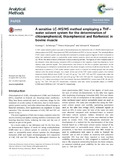A sensitive LC-MS/MS method employing a THF/water solvent system for the determination of chloramphenicol, thiamphenicol and florfenicol in bovine muscle

View/
Date
2014Author
Sichilongo, Kwenga F.
Kolanyane, Prince
Masesane, Ishmael B.
Publisher
Royal Society of Chemistry ,www.rsc.org/Type
Published ArticleMetadata
Show full item recordAbstract
A THF–water solvent system was used in the development of a method for the LC-MS/MS determination of chloramphenicol (CAP), thiamphenicol (TAP) and florfenicol (FFC) in bovine muscle. The tetrahydrofuran (THF)–water solvent system was recently demonstrated to possess superior figures of merit compared to either the methanol–water or acetonitrile–water solvent systems which are almost exclusively used in LC-MS for the determination of fenicols in food producing animals. The figures of merit included ease of de-solvation when electrospray ionization (ESI) is employed in the negative mode thus leading to more intense mass spectral signals. This phenomenon was shown to be due to greater association of the methyl groups in methanol or acetonitrile with the amide nitrogen common in all the three fenicols. This association is absent in a THF–water solvent system since it is devoid of methyl groups that can easily interact with the amide nitrogen. As a result of the use of the THF–water solvent system, the method detection limits (MDLs) were 0.047, 2.1 and 4.3 μg kg−1 for CAP, TAP and FFC respectively while the limits of quantitation were 0.141, 6.3 and 12.9 μg kg−1 for CAP, TAP and FFC respectively. The decision limits i.e. CCα values according to the Commission Decision 2002/657/EC criteria were 0.36, 50 and 111 μg kg−1 for CAP, TAP and FFC respectively. Linearities were also within acceptable values i.e. 0.9983, 0.9916 and 0.9996 for CAP, TAP and FFC respectively.
